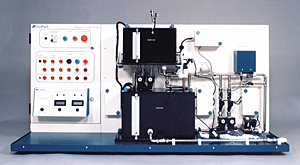|
Industrial Process Trainer
|

|
-
Teaches fault diagnosis & fault finding methodology
-
Self contained process
-
Wide range of easy to apply faults
-
Mechanical, electrical, electronic & process faults
-
May be driven from external PLC or process controller
-
Compatible with PROCON controllers and software
-
Fully protected for safety
-
Comprehensive Instructorís and Studentís Manuals
|
The 34-250 Process Trainer is designed to provide a platform for a student to trace faults down to a detailed level in a systematic way through a relatively easy to understand
process.
Faults can be introduced by the instructor via switches concealed behind a locked compartment to which the student does not have access. These switches provide short circuits and open circuits and can also switch in or out circuit elements to simulate
a variety of fault conditions. Additional faults can be inserted into the process through the replacement of working components with faulty ones. For example faulty float switches, faulty relays, faulty sensors, and blown
fuses.
The system has been designed to teach a methodical approach to fault diagnosis in industrial processes. The methodologies taught within the system are equally relevant to any student or trainee studying fault diagnosis.
Because the process being controlled is very easy to comprehend the trainee does not take a lot of time to understand it.
Designed to be used by people studying industrial process maintenance it can also be used as a process trainer in its own right, using either Electronic Controllers (PID) or Programmable Logic Controllers (PLCís).
The 34-250 is a bench mounted process rig. The process involves initially filling a header tank with water and then cycling the water level between a set upper and lower limit, whilst simultaneously creating a demand from the header tank via two on/off
solenoid drain valves into a sump tank. Flow is produced by a pump and controlled by relay operated on/off solenoid valves which control:
the inflow of water to the header tank
the outflow of water from the header tank
The level of water in the header tank is monitored by float switches which open and close at the following points:
Header tank low (nearly empty)
Header tank normal operation lower limit
Header tank normal operation upper limit
Header tank overflow
Alternative flow and level control strategies can be introduced by the connection of an industrial process controller or a PLC unit with analogue I/O using 4-20mA current loop I/O via a proportional control valve with a pulse flow meter and proportional level
control sensor. The 38-300 Process controller is ideal for this task.
Curriculum Coverage
-
Introduction to the system
-
Fault finding methodologies
-
Fault analysis flow charts
-
Fault finding from circuit diagrams
-
Fault identification to Line Replaceable Unit level
-
Simple electronic fault finding
-
Dignostic tools
-
Maintenance procedures
-
Process control techniques
-
Fault finding processes control-led from electronic controllers
-
Interfacing to Programmable Logic Controllers (PLCís)
-
Fault finding in PLC based systems
The Mitsubishi PLC pack 34-352 or Allen Bradley PLC pack 34-362 can be used with this system to provide interesting examples of Analogue & Digital PLC control.
By adding process faults this rig becomes a powerful training tool for modern process control fault diagnosis training within PLC controlled
environments.
